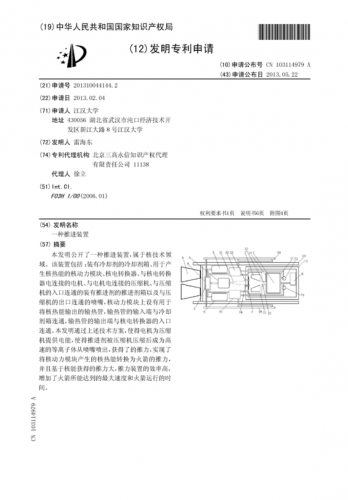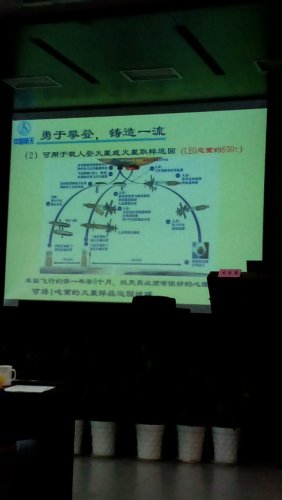Hi.
On January 17, 2014 CASC released an article on their website, dealing with China's future plans in space. This article deals (in the very end) with nuclear space propulsion. Serious business in perspective.
http://www.spacechina.com/n25/n148/n272/n4793/c630721/content.html
Article -> Google translated (slightly edited), included herein:
- - - - - - -
After Shenzhou 10, manned spaceflight focus built "station"
Source: China Space News · Flying science Weekly
Date: 2014/01/17
January 10, at the National Science and Technology Awards Conference held in Beijing , the manned space rendezvous and docking space engineering national science and technology progress prize award. Coincidentally , it was also the media recently reported that within a decade China plans to build its own space station , with an open attitude declared their willingness to carry out international cooperation.
In this regard, there is space enthusiasts might think of some questions below : What are the key technology breakthroughs in China's manned space should follow ? When China built its own space station ? China's future space station look like ?
Space mid-resident : Number of technical problems are solved
From 2011 to 2013, the Tiangong-1 space , rendezvous and docking mission Shenzhou VIII spacecraft completed ten, for the construction of China 's manned space station has laid a good foundation for the future .
Prior to this, the first phase of " Shenzhou " to the " Shenzhou VI" task space shuttles solve technical problems, through the " Shenzhou VII" mission astronaut extravehicular activity technology for a preliminary test. All these work could be seen as preparation for Chinese space station construction.
That means that Chinese space station completion of these construction can start? The answer is not so simple.
As the "Shenzhou nine", "Shenzhou ten" achieved only short-term resident astronauts in space, before actually beginning the construction of the space station, astronauts must also master the technology resides in the mid- space , and by exploring a gradual, continuous and deeper understanding of the treatment of people in space, facing a variety of issues, and ultimately long-term presence in the space station.
In addition, due to the near-earth orbit manned spacecraft to avoid the influence of the radiation belts, mostly orbit at 500 kilometers below, and such a high degree of track affected by aerodynamic drag , orbital altitude constantly decay. Thus, the space station using its own rocket engine needs frequent maintenance of uplift orbit.
For the running time will be over 10 years of the space station, it was not possible to bring all of the propellant enough, which requires the cargo spacecraft propellant tank for the space station be supplemented. In addition , you also need a regular supply of astronauts living and transported by cargo spacecraft testing supplies, enabling astronauts in space long-term presence.
In this regard, aerospace science expert Pang Zhihao said: China plans to launch in 2015 a space laboratory Temple II cargo spacecraft will be launched in the " Temple II " God six months. Compared with the "Temple I", "Temple II" more powerful , the main task is to verify the technical part of the new space station . For example , by cargo ship to the " Temple II " Auto additional propellant, complete the verification test key technologies of regenerative life support, etc. Therefore, the " Temple II " in conjunction with future space station mission closer.
The source pointed out, unlike the current Shenzhou spacecraft and the " Temple" , the future of the space station must use renewable environmental control and life support system . In addition to handling the urine , the person's living environment will all be recycled , recycling water control , room temperature, humidity, carbon dioxide removal, mold processing, and ultimately solve the problem of medical monitoring and other long-term resident .
In addition, the space station module for rocket launcher Long March V, and VII used to launch cargo spacecraft march, could not start the task execution formal launch of these new technologies with a large number of carrier rockets, always arrangements pilot launch mission to verify the design, development is reliable.
2018 China will enter the space station or the times
According to the current China Manned Space Engineering Office has announced plans around 2018 , by carrier rocket Long March V core module test day and number , which will be formally opened the era of Chinese space station sign . If the test core module is operating normally, will launch in 2020 has started testing tanks and asked Sky Survey No. test chamber , and "Heaven " Chinese space station consisting of three-cabin configuration . From 2018 to 2030 , China's space station will be at a height of 340 to 450 km , 42 to 43 degrees inclination orbit for more than 10 years .
In the meantime, the use of existing tools Shenzhou spacecraft as the space shuttles , and each group will be multiplied by 2 to 3 persons, under normal circumstances, can host up to six months in orbit . Every day boat cargo ship can provide up to 6.5 tons of cargo supplies to the space station. In addition to using its own space station chemical propulsion engine, cargo ship 's engines to keep track , but also the use of high performance electric propulsion engines to keep track.
Of particular note is that China is not only a national space station technology lab science, but also for the future of the world , to provide scientific experiment, reception of foreign astronauts , or even greet visiting foreign spacecraft .
Future Chinese people will fly farther
Although you can use the Long March V rockets or rocket Long March VII will be larger, carrying the number of additional new generation manned spacecraft sent to the space station, but referred further manned space flight, such as the moon, Mars, etc., but also need to develop a near-Earth orbit carrying capacity of 100 tons of heavy rocket.
It is reported that the attention the moon , and Mars , our solar system, scientists are on the way within the next manned mission to study. At present, the Chinese Academy of Space Technology is launching the "space-power nuclear propulsion program", the research work, which means that our research in the field of new propulsion technology has taken an important step. (Yang Yuguang )
- - - - - - - - -
A.




